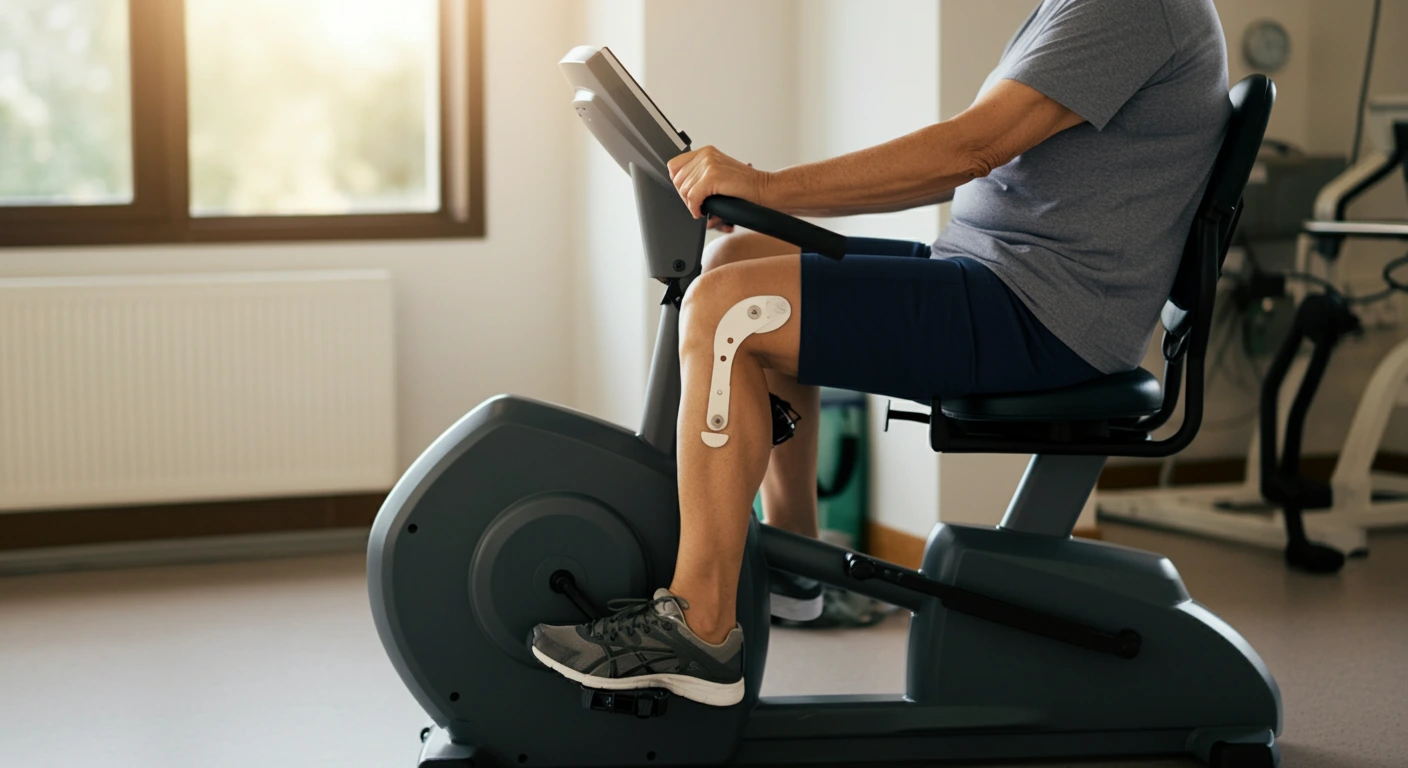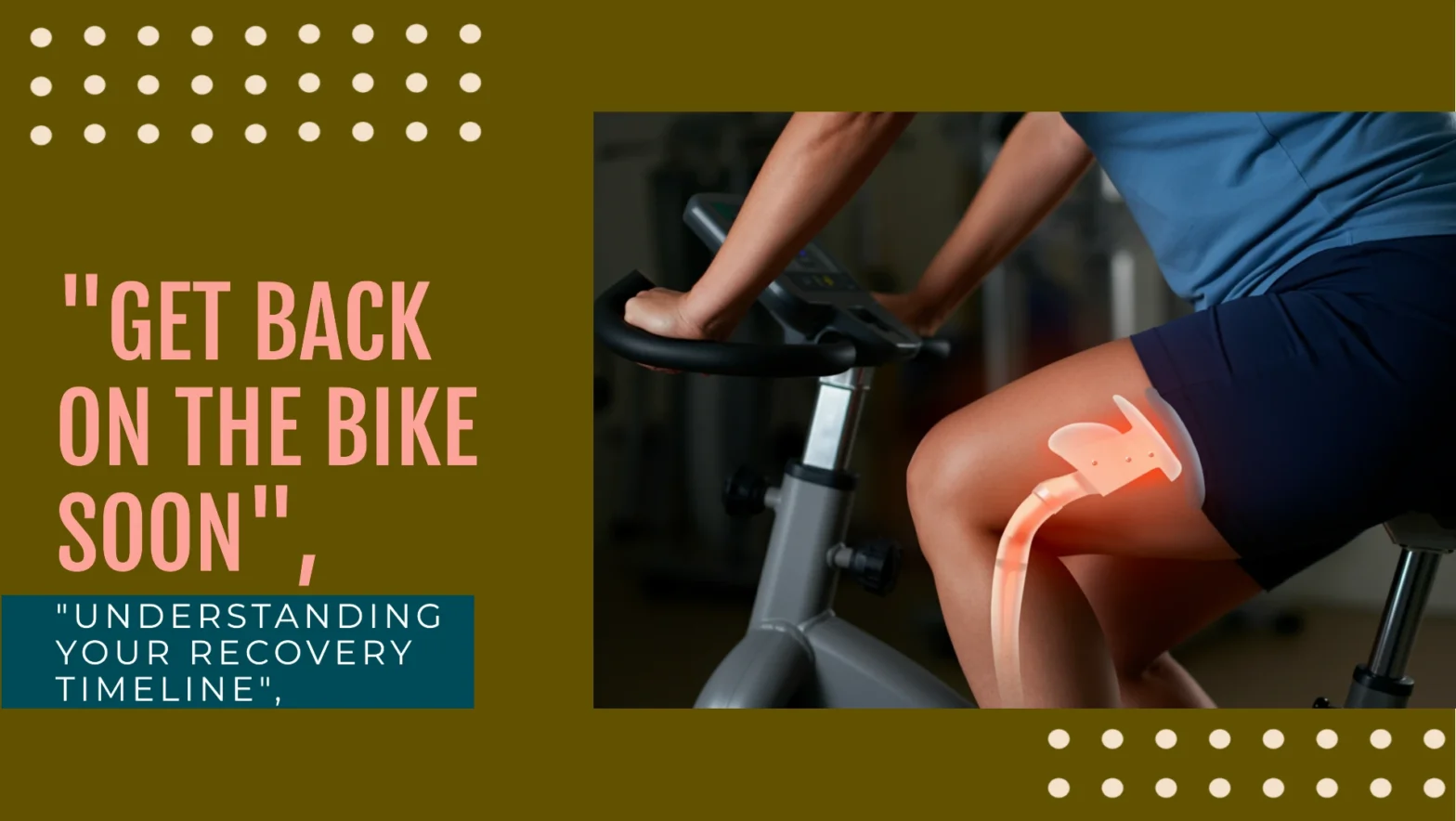After hip replacement, some people ride stationary bikes too early, but this can lead to serious health problems, can lead to a dislocation of the new hip joint, and, if it has fully healed, can lead to complications such as bone fractures. So, everyone should know the right time to ride a stationary bike.
A stationary bike is safe to ride 6 to 8 weeks after a hip replacement. Ensure you follow your surgeon’s instructions and start slowly to avoid any strain on the healing hip joint. You should accumulate the intensity and duration of your workouts only when you feel comfortable.
In this blog post, we will explore when I can ride a stationary bike after hip replacement and the effects of riding one too soon.
When Can I Ride a Stationary Bike After Hip Surgery: 8 Tips
The time to resume stationary bike riding after hip replacement varies based on healing progress. On average, patients can start after six weeks of surgery. The timeline may vary based on the following factors:
- Healing Progress: The healing progress is critical in determining when it’s safe to bike after hip replacements. It is essential to give the hip joint enough time to heal before putting any pressure or strain on it. Riding a stationary bike about six to twelve weeks after hip replacement is entirely safe, depending on the healing progress.
- Surgeon’s Recommendations: Following the surgeon’s recommendations regarding the timing of a stationary bike after a hip replacement is crucial. The surgeon will provide specific guidelines based on the patient’s health history, age, the type of surgery/implant, and overall health and fitness level.
- Pain Levels: Pain levels are essential when starting physical activity following hip replacement surgery. Monitoring pain levels and avoiding any activity that causes discomfort or prolongs recovery time is necessary.
- Range of Motion: The range of motion is the extent to which the hip joint can move. Having an adequate range of movement before starting stationary bike exercises is essential. The range of motion should be about 90 to 120 degrees for safe riding an exercise bike after hip surgery.
- Overall Health and Fitness Level: People’s overall health and fitness level play a critical role in when to do stationary cycling following hip replacement surgery. A person’s fitness level will determine how quickly they can start exercising and how much weight they can bear on the affected hip joint.
- Weight-Bearing Restrictions: Weight-bearing restrictions are essential to consider after hip replacement surgery. Following the surgeon’s weight-bearing restrictions and guidelines is necessary to avoid any complications or delays in the recovery process.
- Type of Surgery/Implant: The type of surgery/implant is essential to consider when starting stationary bike exercises after hip replacement surgery. Different surgical procedures and implants have other recovery times and guidelines, and it’s necessary to follow them carefully.
- Age/General Health: Age and general health play a significant role in recovering after hip replacement surgery. People with underlying health conditions or older patients may take longer to heal and must follow specific stationary bike exercise guidelines.
Best Exercise Bike Before And After Hip Replacement

After a total hip replacement, using an exercise bike can benefit your recovery. Here are some considerations:
- Recumbent Bike: A recumbent stationary bike is often recommended. It provides more support to the lower back and reduces stress on the hip joints, making it safer during the initial stages of recovery.
- Range of Motion: To comfortably ride an upright bike, you’ll need at least 100 degrees of knee flexion. If you have less motion, consider starting with “half rotations,” moving forward and back until you can make a complete revolution. Starting with full revolutions in reverse might be more accessible.
- Exercise Parameters: Gradually increase your exercise time. After completing physical therapy and getting clearance from your doctor, aim for at least 150 minutes of cardiovascular exercise per week.
A couple of recommended recumbent bikes:
- Schwinn 230 Recumbent Bike: Comfortable and adjustable seat, various workout programs.
- NordicTrack Commercial VR21: Provides a smooth and quiet ride with an inertia-enhanced flywheel.
Physical Activity After Hip Replacement
Hip replacement surgery can be a transformative procedure, offering renewed mobility and freedom from pain. Mountain biking, long-distance cycling, and weight training enthusiasts may feel anxious about returning to these activities after surgery. These activities offer insights and tips for living an active and fulfilling life after hip replacement surgery.
Mountain Biking After Hip Replacement
Mountain biking is a thrilling sport that demands strength, agility, and joint mobility. After hip replacement surgery, returning to mountain biking is indeed possible for many individuals, but it requires careful planning and consideration. Here are some key points to keep in mind:
Consultation with your orthopedic surgeon
Before hitting the trails again, it’s essential to consult with your orthopedic surgeon. They can assess your specific case, discuss potential risks, and provide personalized advice based on your recovery progress and the type of hip replacement surgery you underwent.
Gradual reintroduction
Start slowly and gradually reintroduce mountain biking into your routine. Begin with flat, smooth trails to gauge your comfort level and gradually progress to more challenging terrain as your strength and confidence build.
Proper bike setup
Ensure that your mountain bike is appropriately adjusted to accommodate any limitations or changes in mobility resulting from hip replacement surgery. Adjustments such as saddle height, handlebar position, and pedal type can significantly improve comfort and performance.
Focus on technique
Pay close attention to your biking technique, especially when navigating rough terrain or obstacles. Proper body positioning and technique can help minimize stress on your hip joint and reduce the risk of injury.
Long-Distance Cycling After Hip Replacement
Long-distance cycling presents its own set of challenges and considerations for individuals who have undergone hip replacement surgery. However, with proper preparation and caution, many cyclists can return to this activity and enjoy the thrill of the open road once again. Here are some tips:
Build up gradually
Start with shorter rides and gradually increase the duration and intensity as you get stronger. Listen to your body and avoid pushing yourself too hard, especially during the early stages of recovery.
Optimize bike fit

Invest in a professional bike fitting to adjust your bike to accommodate your post-surgery needs and optimize comfort and performance. Pay attention to saddle position, handlebar reach, and pedal alignment factors.
Consider alternative cycling styles
Depending on your comfort level and mobility, certain cycling styles, such as recumbent or upright bikes, are better suited to your post-surgery needs. Experiment with different bike types to see what works best for you.
Incorporate rest and recovery
Long-distance cycling can be physically demanding, so incorporate adequate rest and recovery into your training regimen. Listen to your body and take breaks as needed to avoid overexertion and minimize the risk of injury.
Weight Training After Hip Replacement
Weight training is an excellent way to build strength, improve joint stability, and enhance overall mobility, making it an ideal activity for hip replacement patients. Here are some tips for safely incorporating weight training into your post-surgery fitness routine:
Start with light resistance
Begin with light resistance and focus on performing exercises with proper form and technique. Gradually increase the weight as your strength develops, and your confidence improves, but avoid lifting heavy weights too soon to prevent strain or injury.
Focus on hip-strengthening exercises
Incorporate exercises specifically targeting the muscles around the hip joint, such as squats, lunges, leg presses, and hip abductor/adductor exercises. Strengthening these muscles can help improve joint stability and reduce the risk of complications.
Listen to your body
Pay attention to how your hip joint feels during weight training exercises and modify or avoid any movements that cause discomfort or pain. It’s essential to balance challenging yourself and avoiding undue stress on the hip joint.
Work with a qualified trainer
Consider working with a certified personal trainer or physical therapist with experience working with individuals recovering from hip replacement surgery. They can design a safe and effective workout program tailored to your needs and goals.
How Soon Can I Ride A Stationary Bike After Hip Replacement: 6 Effects
As mentioned earlier, resuming physical activity after hip replacement surgery requires caution and proper timing to minimize the risks of complications. Here are some potential hazards associated with riding an exercise bike shortly after hip replacement surgery:
Increased Risk of Dislocation
The new hip dislocation is one of the most significant risks of resuming stationary biking too soon after surgery. You may get hip pain if your hip is in an unnatural position during physical activity. A dislocated hip joint can cause extreme pain and require further surgery to correct.
Delayed Recovery Time
Resuming stationary biking soon after hip replacement surgery can also cause a delayed recovery time. Your new hip joint needs time to heal, and putting too much strain on it too soon can slow recovery.
Potential Damage to New Hip Joint
You can also damage your new hip joint by using a stationary bike soon after hip replacement. The joint is still healing, and putting too much pressure on it before it’s fully healed can cause complications like bone fractures.
Cycling after Hip Replacement: Pain and Discomfort
Riding a stationary bike soon after hip surgery can be painful. You may experience muscle aches, discomfort around the hip joint, and general fatigue.
Dislodged Hip Prosthesis

Stationary biking early after hip replacement surgery dislodges the hip prosthesis. The hip joint can be put under excessive pressure and strain, making the prosthesis loose. If this happens, you may need further surgery to fix the issue.
Joint Inflammation
Immediately after hip replacement surgery, riding a stationary bike can also lead to joint inflammation around the new hip joint. This can be because of an excessive range of motion, unusual pressure on the joint, or a combination of factors.
Conclusion
A hip replacement can dramatically improve the quality of life for many people. The key to a successful recovery is taking it slow and allowing the body to heal correctly. Riding an exercise bike is a great way to stay active while recovering from hip surgery, but waiting until you get the green light from your surgeon is essential.
Patients can start riding a stationary bike between six and twelve weeks after surgery, but following your doctor’s instructions and listening to your body is necessary. After hip replacement surgery, you can regain strength, mobility, and independence by prioritizing safety and gradually exercising.
FAQs
How Do I Adjust The Stationary Bike To Accommodate My Hip Replacement?
Whenever you ride a stationary bike after hip replacement surgery, it is essential to adjust the seat height so that your hips are at the same level as your knees. This aims to prevent undue stress on the new hip joint.
Should I Take Any Precautions When Riding A Stationary Bicycle After A Hip Replacement?
Taking precautions when riding a stationary bicycle after a hip replacement is essential to ensure a safe and effective recovery. Here are some key precautions to consider:
- Start Slowly: Begin with short sessions at a low intensity to gauge your comfort level.
- Seat Position: Adjust the seat height so that your legs are not fully extended at the bottom of the pedal stroke to avoid overstretching the hip joint.
- Resistance: Keep resistance low to start, gradually increasing it as your strength and endurance improve.
- Listen to Your Body: Pay attention to any discomfort or pain in your hip area, and stop if you experience any.
- Follow Professional Advice: Adhere to the guidelines provided by your healthcare provider regarding the duration and frequency of exercise.
By following these precautions, you can help support your recovery and get back to enjoying cycling.
When can I start cycling on a stationary bike after a total hip replacement?
You can usually begin using a stationary bike 2-4 weeks after a total hip replacement. Start with light pedaling and no resistance, ensuring the seat height is comfortable to avoid straining your hip.
As you regain strength and flexibility, gradually increase the duration and resistance of your cycling sessions. It’s essential to consult your healthcare provider before starting any new exercise post-surgery to ensure it aligns with your recovery plan.
Can I use an exercise bike before a hip replacement?
Yes, you can use an exercise bike before undergoing hip replacement surgery. Strengthening the muscles near your hip joint and upholding joint mobility is beneficial. This low-impact exercise is commonly advised.
Before commencing any new exercise plan, it’s crucial to seek advice from your healthcare provider. They can offer tailored recommendations for safe exercising, considering your present condition and any constraints you may have.
Can I ride a motorcycle after a hip replacement?
Yes, you can ride a motorcycle after a hip replacement. It’s important to wait until you fully recover and have your doctor’s approval before getting back on a motorcycle. Recovery times can vary, but many sources suggest waiting at least 6 weeks before riding to reduce the risk of dislocation.
When you start riding, you may need to adjust your motorcycle to accommodate your new hip, such as modifying the seat for comfort or ensuring the bike’s weight is manageable. Always start with short rides and gradually increase the duration as your strength improves.


